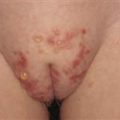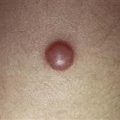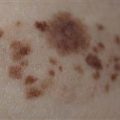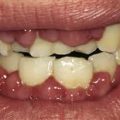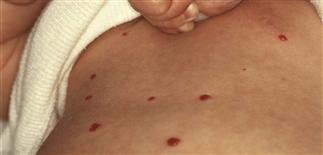
![]() Benign neonatal hemangiomatosis. Multiple small red papules on the trunk of a neonate.
Benign neonatal hemangiomatosis. Multiple small red papules on the trunk of a neonate.

![]() Blanching red papules of diffuse neonatal hemangiomatosis.
Blanching red papules of diffuse neonatal hemangiomatosis.
CLINICAL FEATURES
Diffuse neonatal hemangiomatosis is the association of multiple cutaneous hemangiomas of the skin with similar lesions in internal organs. The skin usually has many small red superficial hemangiomas. The internal hemangiomas may involve any of the viscera: the liver, gastrointestinal tract, central nervous system, and lungs are the most common sites involved. Infants with diffuse neonatal hemangiomatosis are usually ill at birth. The disorder is often fatal secondary to high-output cardiac failure, visceral hemorrhage, obstruction of the respiratory tract or compression of the central nervous system. Most infants with multiple hemangiomas have benign neonatal hemangiomatosis with widespread cutaneous hemangioma without internal organ involvement. In our experience, any asymptomatic infant over 2 months old brought to the dermatology clinic with multiple hemangiomas will not develop systemic disease that requires treatment.
TREATMENT
Most infants have benign neonatal hemangiomatosis, and the hemangiomas will regress as any other hemangioma of infancy and do not require therapy. Prednisolone has been the initial treatment of choice for symptomatic diffuse cutaneous hemangiomatosis, but we believe that propranolol 2–3 mg/kg/day divided in two or three doses will now be used as the primary therapy (see Section 55).

